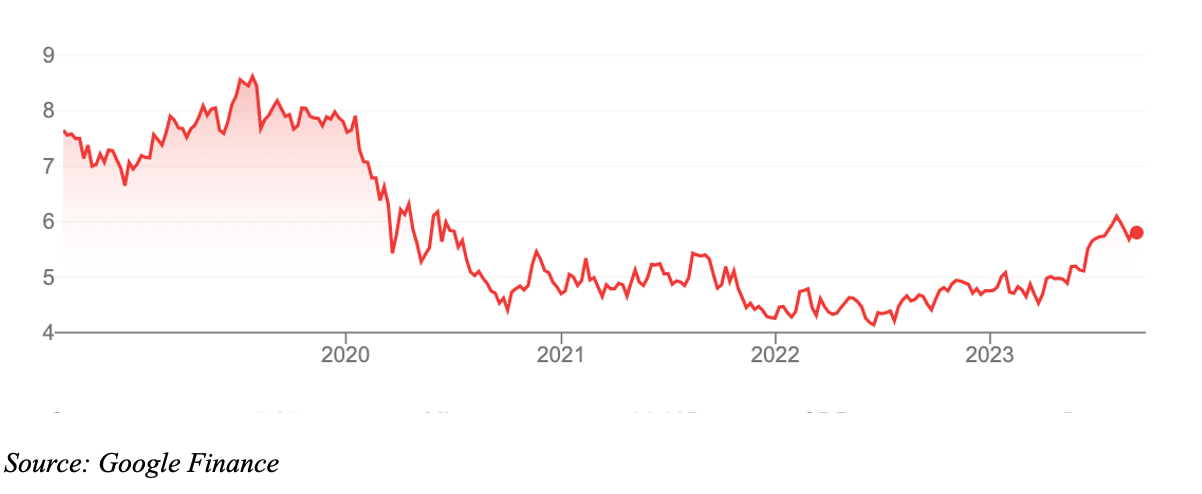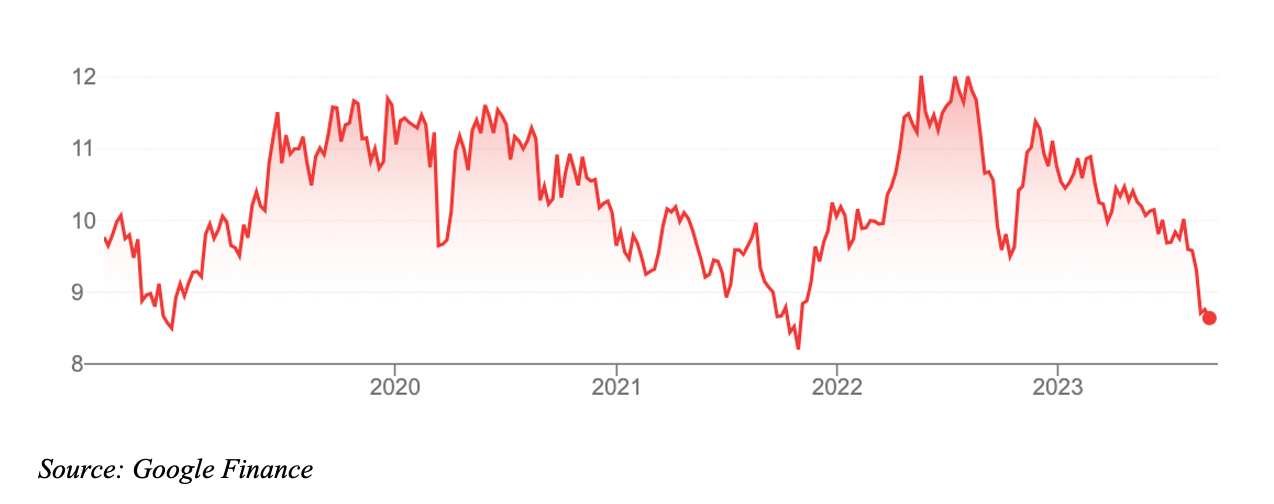It’s amazing how quickly the tide turns for income investors. A year ago, equities were the main game for yield-hungry investors. Now it’s cash.
Bank term deposits paid almost nothing when the RBA cash rate was near zero in early 2022. In contrast, the average dividend yield on the S&P/ASX 200 Index was 4.5%, more after franking credits.
Conservative income investors had to take more risk and buy equities for yield. With the big miners paying juicy dividends last year, thanks to high commodity prices and divestment of fossil-fuel assets, the strategy worked.
This year, some term deposits pay above 5% and the average dividend yield is expected to be around 4%. More telling is the drop in the dividend payout ratio, which has trended lower for a decade. Companies are returning less of their earnings to shareholders as they pay down debt or invest in capex.
This is a difficult period for investors who buy shares for dividends. The two main sources of yield in this market – banks and miners – face strengthening headwinds.
For banks, the risks are high interest rates and a sluggish economy sparking an increase in bad debts. That would hurt bank earnings and dividends.
Mining companies face further falls in commodity prices this year due to the wildcard Chinese economy. Falling property prices and shockingly high youth unemployment are sapping consumer confidence in China.
Large dividend cuts from the miners this reporting season, although expected, are a portent of things to come as miners return to normal dividend payout ratios. The big miners will still offer reasonable yield, but their dividend bonanza is over.
Other sources of yield also look problematic. The Australian Real Estate Investment Trust (A-REIT) sector disappointed this reporting season. Some A-REITs look cheap, but the market underestimated the effect of higher interest costs on the sector and the reluctance of people to return to the office.
Healthcare is out of favour and retail conditions will worsen before they improve as consumers feel the full brunt of high rates and increased living costs.
So, what should income investors do? I have long argued they are better off using specialist managed funds for income rather than investing directly in shares.
I know many investors who have owned the big-four banks, Telstra, supermarkets and a few miners – and done well from a dividend perspective over long periods.
But for conservative investors, it pays to use specialist active funds – either a unit trust or Listed Investment Company (LIC) – to source yield and diversification.
In a stock picker’s market like this one, it’s getting harder to spot companies that can deliver a steady stream of rising dividends. It’s also getting riskier to hold a concentrated portfolio of stocks for yield. Diversification is critical.
Caveats aside, here are two stocks that have reasonable long-term prospects for conservative investors who need to live off the income from their portfolio:
- Insurance Australia Group (ASX: IAG)
In July 2022, I informed readers of the insurance sector’s improving prospects in this report, (Two essential investments for tough times).
At the time, the insurance sector and IAG especially were out of favour. I wrote then: “IAG is my preference among large-cap insurers … IAG has underperformed the market for five years … But every stock has its price … As rates rise and insurance premiums increase, IAG could finally get a break in the weather.”
Rates rose and insurance premiums duly increased (we are all feeling that pain!). IAG has rallied from $4.35 in July 2022 to $5.80 this week – a 33% gain. Even at that level, IAG is still only back to where it traded in mid-2020 during COVID-19.
I like the insurance sector for a few reasons. The first is high interest rates. Insurers are earning more on their investments in bonds and other assets. I think rates will stay elevated for some time, meaning tailwinds for insurers will continue.
The second reason is premium increases. Almost every policy I own has increased its premiums in the past 12 months, some by considerable amounts. Like or loathe it, some insurers have done a good job of pushing through price rises.
The third factor is the weather. Yes, basing investment decisions on long-range weather forecasts is risky. But key forecasters say the odds of a moderate-to-high El Nino effect forming this year are high and rising.
That means drier conditions and, sadly, more bushfires this summer. For insurers, damage from bushfires, which tends to be more isolated, is less costly than floods that can pour through towns, as we saw in Lismore last year.
At $5.80, IAG trades on a forward Price Earnings (PE) multiple of about 16 times and is expected to yield 3.1% (partially franked) this financial year, consensus estimates show. The yield looks a touch low, but the better income stocks usually deliver steady dividend growth over several years, boosting the yield.
The consensus target of $5.88 (based on the 12 analyst forecasts) suggests IAG is fully valued at the current $5.80. I think the consensus is a touch low.
After this year’s rally, IAG is due for a pullback or a pause. But this is a stock that has barely delivered a return over the past five years (on an annualised basis) even after gains this year. It will take time, but IAG’s turnaround has further to run.
Chart 1: Insurance Australia Group

- APA Group (ASX: APA)
I’ve done some work on the utilities sector in the past few months and will have more to say about APA in an upcoming column.
Australia’s largest gas infrastructure company has been a portfolio mainstay for many income investors given its defensive qualities. APA owns a vital network of transmission pipelines, a distribution network and storage facilities.
Some analysts thought APA overpaid for its recent acquisition of Alinta Energy Pilbara for $1.8 billion (part-funded by a $750 million equity capital raising).
The market reacted negatively to the deal with APA shares falling in August. APA is down about 18% over one year and given back most of the gains from its rally in early 2022.
I was more positive on the Pilbara deal. I thought it made strategic sense by increasing APA’s renewable assets, expanding its network and boosting its growth profile and cash flow. Either way, it’s not huge in the scheme of an $11-billion company.
At the capital-raising price of $8.50 for the Pilbara assets in WA, APA is yielding around 7%. The company’s dividend should grow over the next few years and analysts expect it to pay a franked component in the next financial year.
Morningstar’s fair value of $9.50 per APA unit suggests there is a sufficient margin of safety to buy it at the current $8.64.
APA looks a touch undervalued and should deliver higher dividends over the next few years. That’s a good combination for conservative income investors, particularly when the yield comes from a more defensive large-cap utility.
Chart 2: APA Group

Tony Featherstone is a former managing editor of BRW, Shares and Personal Investor magazines. The information in this article should not be considered personal advice. It has been prepared without considering your objectives, financial situation or needs. Before acting on information in this article consider its appropriateness and accuracy, regarding your objectives, financial situation and needs. Do further research of your own and/or seek personal financial advice from a licensed adviser before making any financial or investment decisions based on this article. All prices and analysis at 6 September 2023.

